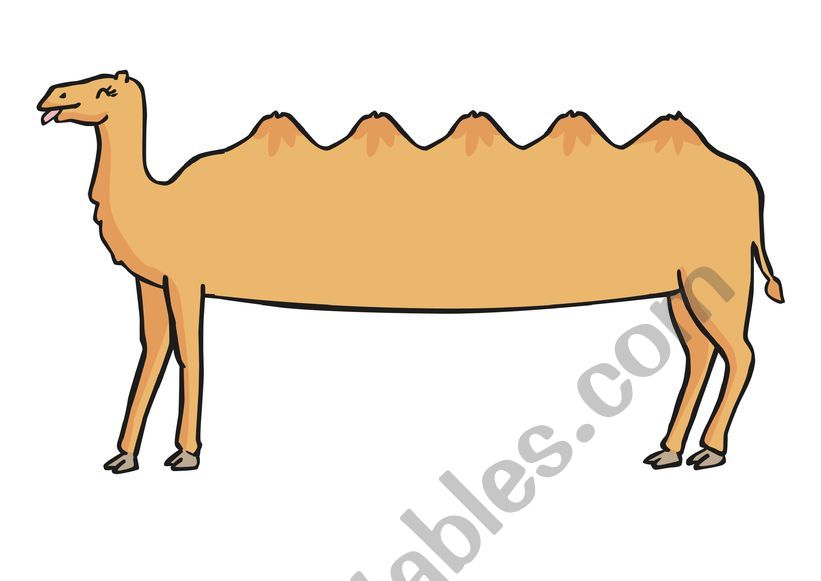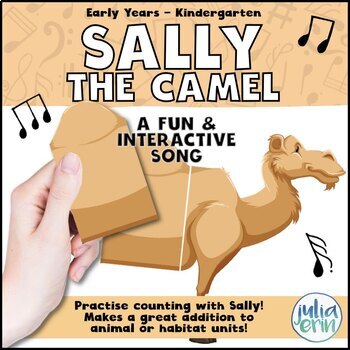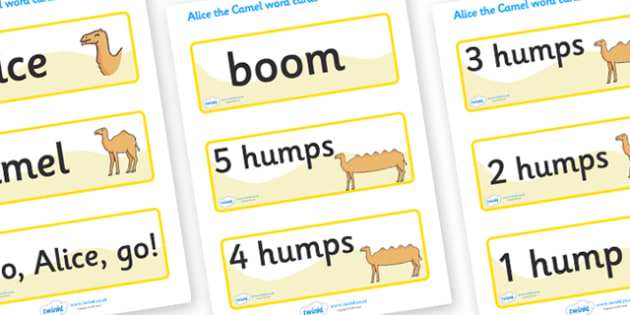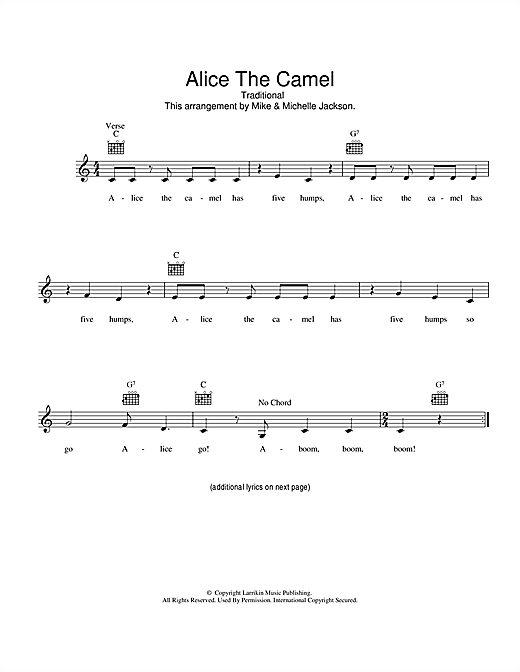Alice the Camel also known as Sally the Camel is a counting song about a camel and its bump or humps. Children sing the song by counting from five humps to zero and conclude by springing the surprising fact that Alice is a horse and not a camel, after all!

So how did this song come to be? I’ll cover that in this article, so let’s dive in.
LYRICS
Alice the Camel has six verses that count down a camel’s humps from five to zero. Some versions count down from 10 as well!
Lyrics for Alice the Camel As Sung Today
Alice the camel has five humps.
Alice the camel has five humps.
Alice, the camel, has five humps.
So ride, Alice, ride.
Boom, boom, boom, boom!
Alice the camel has four humps.
Alice the camel has four humps.
Alice the camel has four humps.
So ride, Alice, ride.
Boom, boom, boom, boom!
Alice the camel has three humps.
Alice the camel has three humps.
Alice the camel has three humps.
So ride, Alice, ride.
Boom, boom, boom, boom!
Alice the camel has two humps.
Alice the camel has two humps.
Alice the camel has two humps.
So ride, Alice, ride.
Boom, boom, boom, boom!
Alice the camel has one hump.
Alice the camel has one hump.
Alice the camel has one hump.
So ride, Alice, ride.
Boom, boom, boom, boom!
Alice, the camel has no humps.
Alice the camel has no humps.
Alice the camel has no humps.
‘Cause Alice is a horse, of course
Sometimes people use Sally as the camels name. You can also use any name but names with two syllables to work best with the tune.
Some versions also replace the word ride with go. You’re free to go with any option you feel comfortable with.
Full Original Lyrics for Alice the Camel
Children have sung Alice the Camel the same way since it first appeared about 31 years ago. Therefore, there isn’t a variance between the modern and original lyric versions.
THE HISTORY BEHIND ALICE THE CAMEL
Who Wrote the Nursery Rhyme Alice the Camel?
The song Sally the Camel became popular in 1991 when it appeared in the film Barney In Concert.
However, the Learning Station also have a version of the song Alice the Camel that counts down from 10 humps.
Jan Hrkach, Donald Monopoli, Laura Monopoli, and Paul Opalach are the musical creators behind the Learning Station. The Learning station is a highly acclaimed group thanks to its vast catalog of children’s music.
It is unclear whether the song existed before the airing of the film. The Learning Station has a career of over 30 years, and it isn’t easy to know if they wrote the song for the film or if it already existed or if the Learning Station created their own version of the song changing the name to Alice and adding on 5 verses counting down from 10.
WHAT DO THE WORDS MEAN?DEFINITIONS
What Does the Nursery Rhyme Alice the Camel Mean?
Alice the Camel has no deeper interpretation. The lyrics are purely for people’s entertainment and to teach counting. The last line is a surprise no one sees coming, further reinforcing the entertainment aspect of the song.
What Is a Camel?
A camel is a tall desert animal with fat deposits on its back called a hump. Camels are domesticated for their meat, milk, and transport, especially in desert areas. Thanks to their fatty deposits in the hum, camels can go a long time without drinking water.
What is a hump?
A hump is the raised part on the back of a camel that stores fatty deposits. The hump is integral to the survival of the camel in desert conditions, besides other adaptations.
INTERESTING FACTS & QUESTIONS ANSWERED

How many humps do camels really have?
The Bactrian species of camel has two humps whereas the dromedary species of camel has one hump.
What’s the Difference Between a Horse and a Camel?
A horse, unlike a camel, has a flat back because it lacks a hump. Camels are also better suited to dry climates like the desert than horses because they have adaptations such as their hump to survive the harsh conditions.
Are There Camels With No Humps?
Only camel calves don’t have humps if we are to consider regular camels only. When a camel calf is born, the area the hump will be is merely skin and flesh. So that part of their body is usually flat. However, after six months, the calf will start growing the hump.
In the broader camel family, only the new world camelids don’t have humps. The New World Camelids are alpacas, vicunas, guanacos, and llamas. These are related to the humped camels having descended from a common ancestor.
The New World Camelids could have lost their humps to changes in their environment. After all, humped camels live in relatively harsh environments in the Middle East, Africa, Mongolia, Australia, and China. They seriously need those humps to help when water is scarce.
Compare harsh desert environments to relatively relaxed areas you’re likely to find llamas and alpacas. You’re more likely to understand why they didn’t need to have humps at all.
Are Alice the Camel and Dry Bones or Dem Bones the Same Song?
Alice the Camel and Dry/Dem Bones are not the same songs. The two share the same tune or melody but the lyrics are about entirely different things.
Dry or Dem Bones is a song now sung as a nursery rhyme inspired by the Christian Bible book Ezekiel that is now used to help children learn about the bones of the body.

Which Came First, Alice the Camel Or Dry Bones (Dem Bones)
Dry bones most likely came first. Alice or Sally the Camel first appeared in 1991. That’s over 35 years since this group performed a version of dry bones in 1955.
For Alice the Camel to borrow a tune from it, the dry bones song will most likely have existed before it. It’s common for most nursery rhymes to borrow tunes from other popular songs or even from each other.
What is the Purpose of Alice the Camel?
Alice the Camel teaches children to count backward. However, its primary purpose is to entertain people. Nothing makes that more evident than the last line in the closing part, where we find out Alice is not even a camel!
Is it Alice or Sally the camel?
You can sing either Alice or Sally in the song. The Learning Station, a highly acclaimed group thanks to its vast catalog of children’s music sing Alice the Camel, but in the version sung on the Barney concert show in 1991 the name Sally is used.
Is Alice the Camel In the Public Domain?
This is extremely hard to tell! Public domain laws generally apply to works produced before 1925. It seems that this song was created after that – but who owns the copyright we couldn’t seem to find that information.
If the controversy over Baby Shark is anything to go by, I would tread carefully if wanting to record this song for your own CD or even for your Youtube channel!!!
What we do know is that if you did make a CD of you singing Sally the Camel or Alice the Camel, your version is not public domain. Therefore, I cannot resell it without your permission – however, you may end up owing some royalties to the copyright owner if there is one – something you would need to do your own research on!
(Disclaimer: These are general–not a legally confirmed facts, and you need to do more research into the laws in your jurisdiction/country to ensure you may use this song)
How Do You Sing Alice the Camel in Sign Language?
You can sing Alice the Camel in Sign language. Here is a resource I found to help you with that.
Alice the Camel Inspired Lesson Plans and Activities
The following is a selection of Lesson Plans based on the nursery rhyme Alice the Camel. You need to click on the images to go to the websites to learn more and download the resources.
SHEET MUSIC FOR ALICE THE CAMEL NURSERY RHYME
What Is the Time Signature for Alice the Camel?
Alice the Camel has a common time signature of 4/4.
How to Play Alice the Camel With an Instrument
You can play Alice the Camel with several instruments. Use the below resources to do that.







